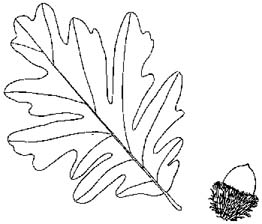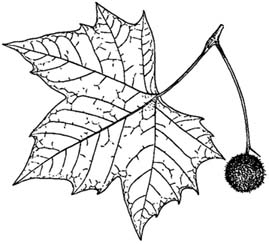Below is the content from page 115 of Trees of Green Lake.
|
Daimyo OAK
Quercus dentata
|
Green Lake's lone Daimyo Oak is perfectly amazing. Flawless, symmetrical, healthy, and larger than any other known on the West Coast, it is the kind of thing usually only dreamed of by tree lovers. Biased as I am, it ill behooves me to speak of these things, but my heart has been so charmed by this oak that I'll venture to suggest that even people who dislike trees might, if showed this East Asian marvel, gulp and concede it a goodly sight and worthy of being seen often. Maybe not, though: William Blake sighed "The tree which moves some to tears of joy is in the eyes of others only a green thing which stands in the way."
|
Its leaves are larger than those of most oaks, measuring up to 15 inches long and 10 inches wide. Numerous finger-like lobes fringe them. They turn a pink-tawny color in fall. The acorns are in unusual bristly cups. The bark is light-colored and rugged in oak fashion.
|
The Daimyo Oak is the largest oak north of the Pitch n' Putt golf course; when measured in 1988 it stood 70 feet tall, 62 feet wide, its trunk 8'7 1⁄2" around. |

drawing by Michael C. Lee; scan by ALJ
|
Below is the content from page 133 of Trees of Green Lake.
|
Hybrid PLANE or SYCAMORE
Platanus x hybrida
|
This is a whale of a tree, truly of monstrous size. Crossing the largest deciduous tree of eastern North America (Sycamore) with the largest of Asia Minor (Oriental Planetree), results in offspring of unparalleled gusto, growing in fifty years to look as if a century old, and when at the 100-year mark, still rapidly increasing in bulk, fully healthy -- even in sites that prove difficult for most trees to endure. In brief, hybrid planes are like comic-book superheroes in their speed, strength and seeming invulnerability.
|
Different clones of the cross have been selected, named and propagated. Most famous is London Plane. Green Lake has no London Planes, mostly having the husky clone 'Pyramidalis'. The trunks are hugely swollen, and almost always flake off their darker outer bark scales to reveal yellow-green, thinner, younger patches -- an unmistakable point of identification.
|
Broad, maple-shaped leaves, shallowly lobed and very short-stalked, are covered in spring with "lint-like" hairs that drift away to the annoyance of breathing animals. Pale brown seedballs 1-2 inches wide dangle in loose array from the twigs in autumn. The fall leaf color is wan yellow.
|
Green Lake's allee of 29 east of the Evans Pool building, planted in the early 1930s, is the most prominent group at the park, although there are 23 additional specimens elsewhere. The largest trunks are 11 feet around. A very unusual specimen is not far from the southwest restrooms. It is enormous, with a less swollen, grayer trunk. Anthracnose affects it more, and it defoliates later. In these respects it is more like the American sycamore.
Back |

drawing from U.S.D.A.; scan by ALJ |

